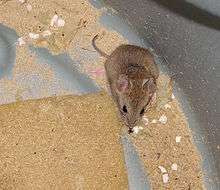Vesper mouse
Vesper mice are rodents belonging to a genus Calomys. They are widely distributed in South America. Some species are notable as the vectors of Argentinian hemorrhagic fever and Bolivian hemorrhagic fever.
| Vesper mouse Temporal range: Pleistocene to Recent | |
|---|---|
 | |
| Small vesper mouse (Calomys laucha) | |
| Scientific classification | |
| Kingdom: | Animalia |
| Phylum: | Chordata |
| Class: | Mammalia |
| Order: | Rodentia |
| Family: | Cricetidae |
| Subfamily: | Sigmodontinae |
| Tribe: | Phyllotini |
| Genus: | Calomys Waterhouse, 1837 |
| Species | |
|
Calomys boliviae | |
| Synonyms | |
|
Hesperomys Waterhouse, 1839 | |
The genus was originally named Hesperomys, but was changed to Calomys since 1962.
History
Hesperomys was introduced by George Robert Waterhouse in 1839 for the American rodents with cusps arranged in two series. The name combines the Greek ἑσπερος "west" and μυς "mouse". He considered it possible that species of Hesperomys would be found in the Old World, but did not doubt that the Americas were their chief abode.[1] He included as species Mus bimaculatus (=Calomys laucha), Mus griseo-flavus (=Graomys griseoflavus), Mus Darwinii (=Phyllotis darwini), Mus zanthopygus (=Phyllotis xanthopygus), Mus galapagoensis (=Aegialomys galapagoensis), Symidon hispidum (=Sigmodon hispidus), Mus leucopus (=Peromyscus leucopus), and the woodrats (Neotoma).[2]
In following years, authors like Johann Andreas Wagner and Spencer Fullerton Baird expanded the genus to include additional American species, such as those placed now in Scapteromys, Oxymycterus, Abrothrix, and Peromyscus. In 1874, Elliott Coues designated Mus bimaculatus Waterhouse as the type species of Hesperomys.[3] In 1888, Herluf Winge used Hesperomys in a sense similar to modern Calomys (but confusingly placed species related to what is now known as Oryzomys in Calomys), but in the same year Oldfield Thomas argued that Hesperomys could not be separated from the hamsters (Cricetus). In 1896, however, he united it with Eligmodontia instead, where it remained until he reinstated it for modern Calomys in 1916. He did not use Calomys (introduced by Waterhouse in 1837 for Mus bimaculatus), because he thought it to be preoccupied by an earlier name Callomys d'Orbigny and Geoffroy, 1830.[4] In 1962, Philip Hershkovitz noted that the International Code of Zoological Nomenclature mandates that a name cannot be considered preoccupied even when it differs by only one letter from another, so Callomys cannot invalidate Calomys. As Calomys Waterhouse, 1837, and Hesperomys Waterhouse, 1839, both had Mus bimaculatus as their type species, the two are objective synonyms and the older name, Calomys, prevails; since then, Hesperomys has no longer been in use as a valid name.[3]
References
- Hershkovitz, 1962, p. 129; Waterhouse, 1839, p. 75
- Waterhouse, 1839, pp. 75–76; current nomenclature: Musser and Carleton, 2005; Weksler et al., 2006
- Hershkovitz, 1962, p. 129
- Hershkovitz, 1962, p. 130
Further reading
- Hershkovitz, P. 1962. Evolution of Neotropical cricetine rodents (Muridae) with special reference to the phyllotine group. Fieldiana Zoology 46:1–524.
- Musser, G.G. and Carleton, M.D. 2005. Superfamily Muroidea. Pp. 894–1531 in Wilson, D.E. and Reeder, D.M. (eds.). Mammal Species of the World: a taxonomic and geographic reference. 3rd ed. Baltimore: The Johns Hopkins University Press, 2 vols., 2142 pp. ISBN 978-0-8018-8221-0
- Tate, G.H.H. 1932. The taxonomic history of the South and Central American cricetid rodents of the genus Oryzomys. Part 1, Subgenus Oryzomys. American Museum Novitates 579:1–18.
- Waterhouse, G.R. 1839. The Zoology of the Voyage of H.M.S. Beagle, under the command of Captain Fitzroy, R.N., during the years 1832 to 1836. Part II: Mammalia. London: Smith, Elder & Co., 80 pp.
- Weksler, M.; Percequillo, A. R.; Voss, R. S. (2006-10-19). "Ten new genera of oryzomyine rodents (Cricetidae: Sigmodontinae)". American Museum Novitates. American Museum of Natural History. 3537: 1–29. doi:10.1206/0003-0082(2006)3537[1:TNGOOR]2.0.CO;2. hdl:2246/5815.* Bonvicino, C.R. et al.. 2010. A new species of Calomys (Rodentia: Sigmodontinae) from Eastern Brazil. Zootaxa 2336: 19–25.
- Musser, G.G.; Carleton, M.D. (2005). "Superfamily Muroidea". In Wilson, D.E.; Reeder, D.M (eds.). Mammal Species of the World: A Taxonomic and Geographic Reference (3rd ed.). Johns Hopkins University Press. ISBN 978-0-8018-8221-0. OCLC 62265494.